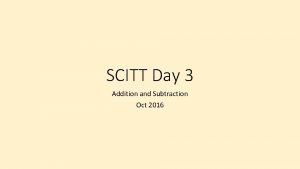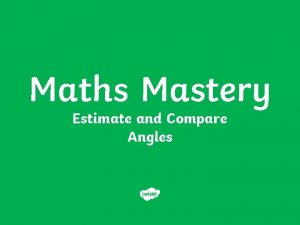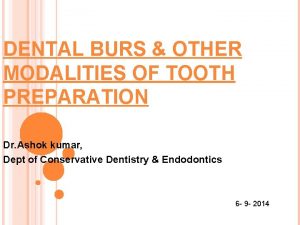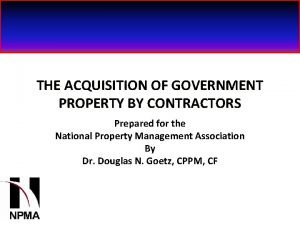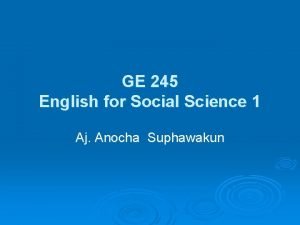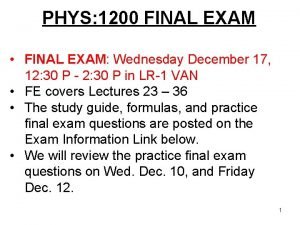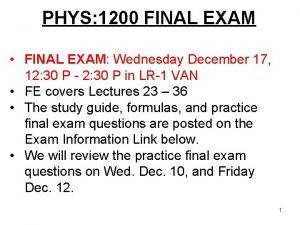PHYS 245 Final Exam The final has two





- Slides: 5

PHYS 245 Final Exam The final has two parts which will be labeled • Test 4: This is a test on the parts of Chapters 30, 31, 32 and 33 that were covered. • Cumulative: This covers Chapters 16 33 except for Ch 29. • Some of the problems/questions on the Cumulative part will also count in your Test 4 score. These ‘dual use’ problems/questions will be marked with the ‘**’ symbol for your information. • I am including these ‘dual use’ items in order to reduce the time disadvantage felt by students who have to take both parts • The whole exam (Cumulative plus Test 4) will be about twice as long as a regular test but you will have triple the time ( 65 minutes vs. 50 minutes) so I don’t expect that time will be as big a factor as on the tests

My Philosophy of Tests &Exams 1. Tests should cover a mixture of major and minor topics 2. Final Exams should cover major topics but since Chapters 30 -33 have not been on a test, there may be questions on minor topics from this material. • I have included on the next slide a list of what I consider major topics. It should be noted that some of these topics are from the Test 4 chapters and they may also appear in the Cumulative part. . • The review lecture will cover the first three topics listed on next page if there is time. I will not be able to have a review session in the afternoon. • The equation list at the end of these notes is subject to change. • Students must bring photo ID to exam

Final Exam Notes • List of major topics • Electric circuits and power • Electric Potential and electric and magnetic fields • Lenses • Half-life processes (RC and radioactive decay) • Quantum Physics • Mass-Energy problems (Relativity & Nuclear Physics) • Nature of Electromagnetic Radiation • Elementary Particles • Structure of Matter (Atoms, Nuclei)

Coverage of Ch 30, 31, 32 & 33 • These chapters will be on the part labeled Test 4 and also the part labeled Cumulative, so everyone must study this material. • The best guide to the coverage of these chapters is the lecture notes. You need to know everything in the lecture notes. The text much material that you are not responsible for. • Since this material was not covered by a test, some questions on relatively minor topics will be included. The notes are a good guide to Ch. 30, 31, 32 and 33. • Ch 30 we covered 30. 13 • Ch 31 we covered 31 -1 to 31 -4 • Ch 32 we covered 32 – 2, 3, 4, 5, 6, 9, 10, 11 partially • Ch 33 we covered 33 -1, 4, 5, 7, 8 partially • Numeric problems will come from Chapter 30, 31 as well as Hubble’s law.

1/2= 0. 693 RC. Mass of electron = me = 0. 00054858 u = 0. 511 Me. V/c 2 = 9. 11 x 10 -31 kg. Mass of proton = mp = 1. 007276 u = 938. 27 Me. V/c 2 = 1. 67265 x 10 -27 kg. Mass of neutron = mn = 1. 008665 u = 939. 57 Me. V/c 2 = 1. 67495 x 10 -27 kg. Planck’s Constant = h = 6. 626 x 10 -34 J s = 4. 14 x 10 -15 e. V s h / (2 ) = 1. 0546 x 10 -34 J s = 6. 59 x 10 -16 e. V s 1. 0 e. V = 1. 6 x 10 -19 J Electronic charge = 1. 6 x 10 -19 C c 2 = 931. 5 Me. V / u Speed of Light c = 3. 00 x 108 m/s Coulomb constant k = 9. 00 x 109 N·m 2 / C 2 Hubble Constant = (22 km/s) / (106 light years) 1. 0 year = 3. 1 x 107 seconds
